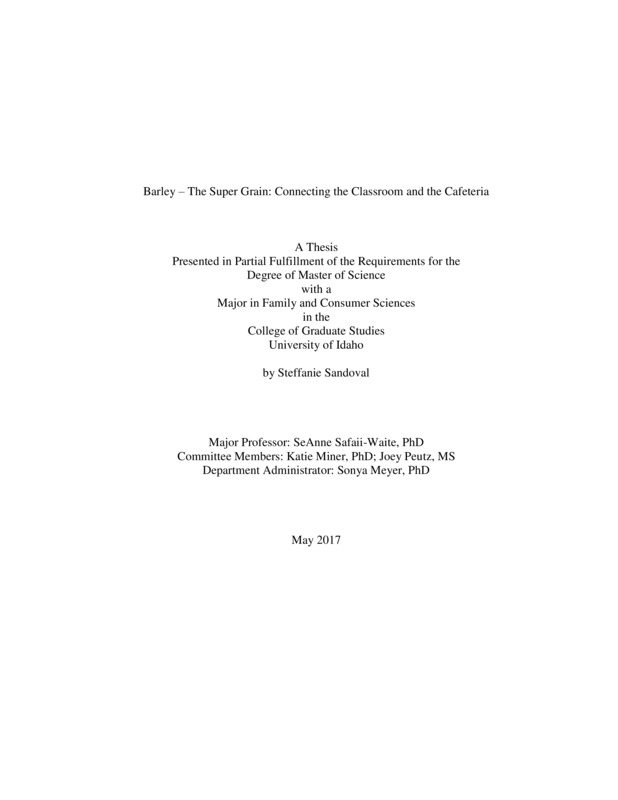Barley - The Super Grain: Connecting the Classroom and The Cafeteria
Sandoval, Steffanie Lynne. (2017). Barley - The Super Grain: Connecting the Classroom and The Cafeteria. Theses and Dissertations Collection, University of Idaho Library Digital Collections. https://www.lib.uidaho.edu/digital/etd/items/sandoval_idaho_0089n_11094.html
- Title:
- Barley - The Super Grain: Connecting the Classroom and The Cafeteria
- Author:
- Sandoval, Steffanie Lynne
- Date:
- 2017
- Keywords:
- Cafeteria and Classroom Education Nurtition Plate Waste Repeated Exposure
- Program:
- Family and Consumer Sciences
- Subject Category:
- Nutrition
- Abstract:
-
Objective
To develop and implement nutrition education material using the social cognitive theory on the health benefits of barley and to test the impact of the education on acceptance and liking of a barley recipe in the school cafeteria.
Methods
Two nutrition education curricula were developed by dietetic students using the social cognitive theory and were edited by a graduate student co-researcher. The nutrition education material were developed based on the age groups 1st through 3rd grade and 4th through 6th grade. Protocol development through literature and researcher input was followed by protocol training for dietetic students who assisted with data collection. Lunchroom data collection sessions were done at 2 elementary schools, one control school and one intervention school, for 1st through 4th graders on two occasions: prior to nutrition education activities, and after nutrition education activities. SPSS Paired sample sign tests with a significance level of P ≤0.0 5were used to measure changes in survey responses for students participating in the nutrition education activities at the intervention school.
Results
From pre to post study, there was a significant increase in the first through third grade children’s knowledge of barley, a significant increase in the reported consumption of barley at home, and a significant increase in the liking of barley. From pre to post study, there was a significant increase in the fourth grade children’s knowledge of barley, no significant increase in reported consumption of barley at home, and a significant increase in the liking of barley.
Conclusions and Implications
At the end of nutrition education activities, students at the intervention school reported an increase in knowledge and liking of barley. Results suggest, providing nutrition education with cafeteria exposure of a barley recipe may lead to increase acceptability and liking of a barley recipe.
- Description:
- masters, M.S., Family and Consumer Sciences -- University of Idaho - College of Graduate Studies, 2017
- Major Professor:
- Safaii-Waite, SeAnne
- Committee:
- Peutz, Joey; Miner, Katie
- Defense Date:
- 2017
- Identifier:
- Sandoval_idaho_0089N_11094
- Type:
- Text
- Format Original:
- Format:
- application/pdf
- Rights:
- In Copyright - Educational Use Permitted. For more information, please contact University of Idaho Library Special Collections and Archives Department at libspec@uidaho.edu.
- Standardized Rights:
- http://rightsstatements.org/vocab/InC-EDU/1.0/

